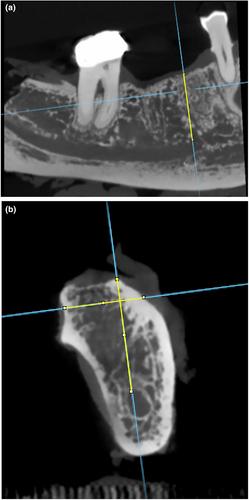Low-dose, standard, and high-resolution cone beam computed tomography for alveolar bone measurements related to implant planning: An ex vivo study in human specimens
Abstract
Aim
To evaluate the performance of low-dose cone beam computed tomography (CBCT) protocols with regard to linear bone measurements in the posterior mandible for implant planning compared with higher dose protocols.
Materials and Methods
Forty-two edentulous posterior sites in human cadaveric mandibles were imaged in three CBCT scanners using three or four protocols with varying exposure parameters to achieve lower dose. Co-registration was performed to generate sagittal and cross-sectional image sections representative of the implant site. Three observers measured bone height, from the alveolar crest to the mandibular canal, and width, three mm from the top of the alveolar crest. Intra- and interobserver reproducibility were assessed for the cases rated as nonmeasurable as well as for completed measurements. The measurements were analyzed using paired t-tests for differences among the CBCT protocols and the frequency distribution of nonmeasurable cases with a Pearson Chi-square test.
Results
Reproducibility for registering nonmeasurable cases varied among observers; however, no consistent significant differences were found in the frequency distribution of these cases among observers, units, and protocols. Intraclass correlation coefficients (ICC) were >0.9 for all measurements of bone height and width. Mean differences of <0.5 mm were found regardless of protocol; however, one observer did in some cases produce larger differences.
Conclusion
Linear bone measurements did not differ significantly and could be performed with excellent reliability, using low-dose CBCT protocols compared with standard and high-resolution ones. Varying approaches for rating nonmeasurable cases were found, indicating differences in diagnostic strategies related to implant planning among observers.


 求助内容:
求助内容: 应助结果提醒方式:
应助结果提醒方式:


